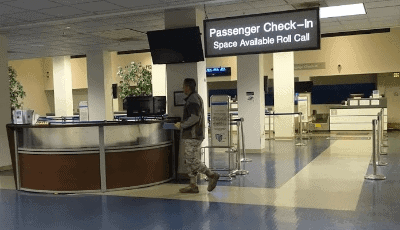If you’re a veteran looking for a budget-friendly way to travel, military space-available (Space-A) flights offer an incredible opportunity. Space-A allows eligible passengers to fill unused seats on military aircraft — at little or no cost. We’ve flown Space-A around the world, saving thousands of dollars while having some pretty cool adventures along the way.
The key to flying Space-A is understanding how the system works and planning accordingly.
Who Can Use Space-A?
Two groups of veterans are eligible for Space-A travel:
- Retirees (including veterans who were medically retired)
- Veterans with a 100% permanent and total VA disability rating
Space-A passengers are divided into six categories or “Cats” based on duty status and reason for travel. Cat 1 is the highest priority and Cat 6 is the lowest. Veterans are in Cat 6, but some have restrictions on where they can fly. All eligible veterans can fly Space-A with their dependents listed in DEERS.

Where Can You Travel with Space-A?
While you could see a flight to just about anywhere in the world, most flights are between U.S. military bases. There are also two Air Mobility Command (AMC) terminals at civilian airports: one at Seattle Tacoma International, which has flights to Guam and Asia, and the other at Baltimore Washington International, which flies to Ramstein AB. The majority of opportunities to fly Space-A are via the US, Asia, the Pacific, and Europe.
How Space-A Works
As Space-A passengers, it’s on us to figure out whether we can make flying Space-A fit with our travel plans by understanding when and how to use it.
Fly Space-A when you have time, flexibility, and a spirit of adventure. Fly commercial when you need to be somewhere by a certain date or you have only a short time (e.g. less than a week) for your vacation.
Here’s a summary of the Space-A process with links to more detail:
- 1. Signup/Registration
Sign up with every military passenger terminal from which you might fly. Your registration is good for up to 60 days at most terminals. You’re not signing up for a particular flight. You’re notifying the passenger terminal that you want to depart from there sometime in the next 60 days.
- 2. Track Flight Schedules
Schedules are published on the AMC website. You can also call or visit a terminal to get their current schedule. Most flight schedules are posted 72 hours in advance, except for Patriot Express (“rotator”) schedules, which are published one calendar month at a time. This guide explains where to find AMC terminal flight schedules and how to read them.
- 3. Mark Yourself Present
This is the point in the process when you’re telling the terminal which flight you want to take. When you see a flight you want to try for, go to the terminal up to 24 hours before the time listed on the schedule and “mark yourself present.” Bring the military IDs and passports (if traveling overseas) of all passengers.
You can also mark yourself present an hour or two before the flight. Just make sure you allow enough time to do it before Roll Call starts.
- 4. Roll Call
Passenger terminal staff read the names of the Space-A passengers selected for the flight. They start with travelers in lower-numbered (higher priority) categories and, if there are still seats, work their way down to Category 6.
If your name is called, go to the desk and confirm that everyone in your party is there and ready to go. Usually, they send you to check luggage right after you are selected for the flight.
Didn’t get selected? Wait in the terminal, at least until the flight boards. Sometime extra seats are released at the last minute.
- 5. Luggage Check
On most flights, each passenger can check up to two bags weighing 70 lbs each, but some aircraft or missions have much lower weight limits.
When checking luggage, you may have the option to purchase a box meal (usually $10 or less). You will also get your boarding passes.
- 6. Boarding
After you check your luggage, you may wait several more hours to board. We’ve also hopped cargo missions where we boarded asap, so prepare for either scenario.
You will go through security, just like at a civilian airport, and wait in a secure area before boarding. Usually, a van or bus will take Space-A passengers to the aircraft, and you will board from the flight line.
- 7. Flight
The flight experience depends on the type of aircraft. If it’s a Patriot Express (aka “rotator,” expect a regular passenger plane with in-flight service. For most other missions on cargo aircraft, it’s usually cold and loud, so dress in layers and bring a small inflatable mattress so that you can stretch out on the floor if there’s room. (Get a full Space-A packing list).
For the full step-by-step process, check out my detailed guide on how to fly Space-A.
Tips for Successful Space-A Travel
Here’s how to make the most of Space-A:
- Stay flexible. Open-ended travel dates and backup plans help you take advantage of available flights. Don’t wait for the perfect flight: “take the first thing smokin” (aka the first flight headed in the direction you want to go).
- Aim for off-peak times. Traveling when schools are in session and outside of the busy summer PCS season increases your chances of getting a seat.
- Pack smart. Bring what you need for long waits at the terminal — snacks, entertainment, and patience go a long way.
- Keep learning. The best way to have a successful Space-A adventure is to arm yourself with as much information as possible. Continue your research so that you understand all steps in the process, what to pack, what to expect during the flight, and what to know about military passenger terminals you might transit.
Space-A travel gives veterans the chance to explore the world in a unique and affordable way. With the right mindset and preparation, you can turn this military benefit into your ticket to adventure.
Bio: Stephanie Montague is the founder and president of Poppin’ Smoke, a website dedicated to helping members of the military community take advantage of their travel-related benefits. She has been traveling and living abroad with her husband since he retired from the Army in 2015. Through Poppin’ Smoke, Stephanie shares everything she and her husband learn about Space-A travel and using their military benefits all over the world.
Also, through her Facebook group, Stephanie facilitates a large and growing community of veterans who are interested in living overseas after their military career.
Find Stephanie on Facebook and Instagram.
From John
Space-A is a great benefit for Vets, if you’ve got the time and the patience. Make sure to check out Poppin Smoke, a big thanks to Stephanie for writing this article and her incredible work. She is a pioneer, writer, community builder and traveler. If you want to move abroad check out my book Veterans in Paradise: The Veterans Guide To Moving Abroad
